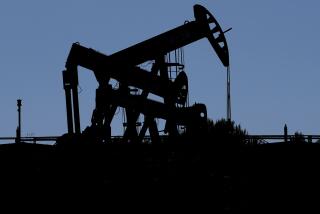War Opened New Era for Oil Industry : Energy: Prices have stayed low, and a glut is developing. But the world’s oil balance is vastly different, experts say.
- Share via
In the ravaged oil fields of Kuwait, a layer of viscous, asphalt-like oil still coats the sand, the remnant of well fires and war that disrupted the world’s oil supply a year ago.
But here and there, tiny white mounds have sprung up where hardy desert ants have pushed through the hard pack to thrive anew.
To some, they are a symbol of a recovery that came faster than expected throughout Kuwait.
Indeed, the entire world’s oil industry has bounced back remarkably well just a year after the Persian Gulf crisis and ensuing war cut off vital oil supplies from the Middle East and sent prices soaring. Analysts say:
* Serious shortages never developed, and other oil nations--led by Saudi Arabia--boosted production much higher and quicker than expected to make up for the shortfall from Iraq and Kuwait.
Now, total oil production by the Organization of Petroleum Exporting Countries is at an 11-year high, even though Iraq and Kuwait are pumping at only a fraction of their prewar levels. More than a third of OPEC’s total now comes from Saudi Arabia, which has surpassed the United States as the world’s second-largest producer of oil.
* More than 650 oil well fires were extinguished, and the rehabilitation of other oil production facilities in Kuwait proceeded much faster than initially expected. Putting out the fires--the most ambitious project of its kind ever--took only eight months. Kuwait is now close to producing 400,000 barrels of crude oil a day, less than a third of its prewar production, but expects to be up to prewar production levels by the end of the year.
* After the war, the expected decline of oil production from the disintegrating Soviet Union, the world’s largest producer, did not rock the oil markets of the West as feared, in part because demand for oil fell in the former East Bloc nations of Europe as their economies faltered.
* A world glut of oil has resulted from a milder than normal winter and OPEC oil production that is still in high gear. That has caused world oil prices to fall to pre-crisis levels: less than $18 a barrel in the United States.
In some ways, the world is back where it was before Iraq invaded Kuwait on Aug. 2, 1990. In other significant ways, however, the world’s oil balance is dramatically different, and that has been apparent at OPEC meetings in the last year, observers said.
OPEC ministers long ago abandoned their sweeping ceremonial robes in favor of London-tailored business suits. But they still argued rancorously in their closed-door sessions and declaimed bitterly against one another in public statements.
Before the crisis, the cartel was deeply divided. On the one side were price hawks, led by Iraq, who favored squeezing production to boost revenues. On the other were price doves, led by Saudi Arabia, who favored high production and low prices to stimulate world demand for crude oil. At the last meeting in the month before the invasion, a saber-rattling Iraq prevailed.
“Iraq was calling the shots almost 100%,” said Vahan Zanoyan, a senior director at Petroleum Finance Co. in Washington. “The agenda, the outcome, was dictated by Saddam (Hussein).”
The meetings following the war are much less contentious.
The war greatly diminished the influence of Kuwait, the most extreme price dove, and the U.N. embargo has eliminated Iraq as a major player in world oil markets.
That has left Saudi Arabia the big winner and the dominant force in OPEC. Indeed, if the continuing decline of Soviet oil production is not reversed, Saudi Arabia could end up as the world’s largest producer of oil in the near future.
At last year’s meetings, “The Saudis were cocky as hell, acting like they won the war,” Zanoyan recalled.
Although there are still strong dissenters--notably Algeria, where fundamentalists are gaining political strength, and Iran--they have little power to sway the cartel’s decisions. Moreover, many of the more flamboyant ministers have been replaced, leading to less heated confrontations.
“There are no more rock stars, no more prima donnas,” Zanoyan said.
Until this week, the Saudis have shown little interest in cutting oil production to boost world oil prices. Analysts interpret that as a personal favor by Saudi King Fahd to U.S. President George Bush, who needs help reviving the ailing U.S. economy.
Despite calls by Iran and Algeria, it seems unlikely OPEC will convene a special meeting to discuss production cuts before the next regular meeting in February.
Saudi Arabia’s oil production has risen from about 5.4 million barrels a day before the Iraqi invasion to as much as 8.4 million barrels a day now. As a result, the price of the “basket” of seven OPEC crude oils has fallen below $17 a barrel, well under the official minimum reference price of $21.
At the height of the crisis, nervousness spurred crude oil prices to more than $40 a barrel. But unlike earlier oil crises, no serious shortages or massive hoarding took place. Analysts credited new market mechanisms, the existence of national strategic oil reserves and cooler heads in governments.
“Past lessons were learned well in terms of dealing with the crisis, and everyone behaved rather well,” said Fereidun Fesharaki, a former energy adviser to the Iranian government and director of resources programs at the U.S. government-funded East-West Center in Honolulu.
The current glut of oil has come at the same time that recession in consuming nations has slashed demand. That portends even more oversupply--a threat that takes on greater urgency as Kuwait and Iraq promise to resume oil exports sooner than expected.
The ceremony that snuffed the last Kuwaiti oil fire took place long before experts predicted. “If you had told me we could get it done in 8 1/2 months when we started, I would have called you a bald-faced liar,” said Larry Flak, coordinator of the oil well firefighting project and chief engineer for the consulting firm of O’Brien Goins Simpson Inc. in Houston. Kuwait now has seven drilling rigs operating.
Iraq, meanwhile, is talking with the United Nations about a partial resumption of oil exports to pay for food and medicine. In September, the United Nations agreed that Iraq could export $1.6 billion worth of oil.
If such sales resume, prices could fall even lower--helping beleaguered economies, but hurting oil company profits and revenue in producing nations.
Many analysts foresee prices hovering around $20 or $22 a barrel in 1992, particularly if demand strengthens as economies recover. But a report by Salomon Bros. is much less sanguine. With continuing slack demand and swelling world inventories, the brokerage forecasts oil prices dropping to $15 a barrel or lower in the next several months--unless Saudi Arabia agrees to massive production cuts.
The glut likely won’t be affected by the decline in Soviet oil production, analysts say.
That decline is likely to continue, given the antiquated equipment, poor management techniques, lack of capital and bad condition of former Soviet oil fields.
Production fell 9.6% in 1991--to 10.3 million barrels a day--from 11.4 million barrels a day in 1990, said Matthew Sagers, director of energy services at the consulting firm PlanEcon Inc. in Washington. At the same time, exports fell by about one-third from 1990 to 1991, he said.
But the effect on Western supplies has been “zippo,” he said. The reason: Demand for oil in Eastern Europe, the destination of much of those Soviet exports, is way down, and the former Soviet republics have been shipping more to the West. “The net draw on OPEC or the rest of the world has been virtually no change,” he said.
The world’s oil supply remains relatively secure for now, particularly with the cozy relationship between Saudi Arabia and the United States.
But as the turmoil in Algeria suggests, things can always change in the volatile Middle East. G. Henry M. Schuler, director of the energy security program at the Center for Strategic and International Studies in Washington, sounded an ominous warning: “The current low prices and the perceived willingness of (King) Fahd to cooperate (with consuming nations) has already resulted in increased U.S. and international reliance on the Middle East. (But) history will tell us that (the war) has increased instability in the region . . . and I think that we’ll yet pay the price for the Gulf War.”
World Oil Production Remains Stable Despite the loss of Kuwait and Iraqi oil production during the Persian Gulf crisis and ensuing war, world oil supplies remained strong due to higher production, mainly from Saudi Arabia. Even the United States arrested and reversed the historic decline in its own oil production for a time. The world’s largest producer, the former Soviet Union, continued to see falling production, but its exports remained stable, analysts said. Source: Energy Information Administration
More to Read
Sign up for Essential California
The most important California stories and recommendations in your inbox every morning.
You may occasionally receive promotional content from the Los Angeles Times.










